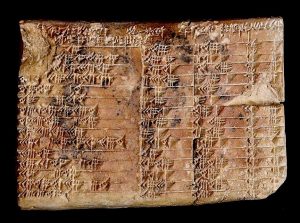An ancient tablet that demonstrates undoubted genius

For nearly 100 years, the mysterious tablet above (no, it’s not an iPad) has been referred to as Plimpton 322. It was first discovered in Iraq in the early 1900s by Edgar Banks, the American archaeologist on which the character Indiana Jones is thought to have been largely based.
Now researchers from the University of New South Wales are calling it one of the oldest and possibly most accurate trigonometric tables of the ancient world.
Findings published in the journal Historia Mathematica, the official journal for the International Commission on the History of Math, reveal how researchers dated the ancient clay tablet and came to conclusions about its use.
The tablet is arranged in a series of 15 rows intersected by four columns. According to the UNSW researchers the tablet uses a base number of 60, which may have been used to allow ancient Babylonians to derive integers instead of fractions.
Norman Wildberger, explained that the research team reached their conclusions that the tablet was used for the study of triangles by findings based on ratios, not angles. In the top row of the tablet, said Wildberger, relatively equal ratios create a near equilateral triangle. Descending down the tablet, the ratios decrease the triangle’s inclination, creating narrower triangles.
“It is a fascinating mathematical work that demonstrates undoubted genius,” said University of New South Wales researcher Daniel Mansfield in a press release.
The researchers speculate the tablet could have been used to survey fields or construct buildings. For example, knowing the height and width of a building, ancient builders would have been able to calculate the exact measurements need to build pyramid slopes. (source: National Geographic)
Watch more here…
